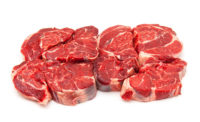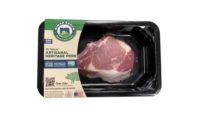Editor’s note: The following article is a short version of a presentation for the AMSA International Lectureship Award, held at the Reciprocal Meat Conference in June in Kansas City.
Different types of packaging for fresh beef, lamb, pork and poultry products can be seen in retail cases across the United States. These different types of packaging were created to allow for shelf stability of product. This includes protecting against contamination and spoilage of the product, stabilizing the red color that is most attractive to consumers and preventing lipid oxidation and development of off flavors.
Oxygen-permeable film covering trays of Styrofoam and other materials is a common type of packaging in the retail case. The permeable overwrap allows large amounts of oxygen to reach the surface of the product, causing the bright red color that consumers expect to see in fresh meat due to formation of oxymyoglobin. Vacuum packages often presented as chub or skin packages remove oxygen from the product, producing a purple-colored product rather than bright red, because of the presence of deoxymyoglobin. Finally, there are multiple variations of modified atmosphere packaging (MAP) employing mixtures of carbon dioxide, nitrogen, oxygen and/or low carbon monoxide. The benefit of using carbon monoxide is that carboxymyoglobin is formed, which gives the product a cherry red color that is desirable to consumers. When low concentrations (≤ 0.4 percent) of carbon monoxide are added to high carbon dioxide gas blends, an ideal combination of attractive color, extended shelf life and low food waste is achieved.
Norway’s meat industry and retailers are utilizing all oxygen-free packaging through use of MAP with carbon dioxide and nitrogen blends, vacuum and skin-packs. These packaging options increase the shelf life of the products as well as decrease food waste. Ground beef, pork and chicken in 60 percent carbon dioxide/40 percent nitrogen have a shelf life of 14 to 21 days. While beef steaks sold in skin-packs have an even longer shelf life of approximately 24 days. In comparison, high oxygen packaging only gives a shelf life of nine to 10 days for ground beef. For a short time, a retail group in Norway made a switch from no-oxygen MAP to high-oxygen MAP (70 percent oxygen/30 percent carbon dioxide). After this change, registrations were conducted to determine differences in food waste when using these two types of packaging (Møller et al., 2016). Over a nine-month period, mean food waste in the stores for high oxygen packed product was 8.7 percent, while carbon dioxide/nitrogen packaged product only had 2.5 percent waste.
Research in markets in Denmark, Norway and Sweden determined consumer preferences among skin packaging, high oxygen (80 percent oxygen/20 percent carbon dioxide) packaging, and oxygen-free packaging with carbon monoxide (69.6 percent carbon dioxide/30 percent nitrogen/0.4 percent carbon monoxide) (Aaslyng et al., 2010). Consumers in all three countries preferred skin packaging and least liked product from the high oxygen packaging. Oxygen-free packaging options offer many benefits when compared with high oxygen, such as a stable purple color, no premature browning of the inner parts of cooked meat, no rancidity and therefore no need to use antioxidants, and an extended microbiological shelf-life which in turn leads to reduced food waste. The main disadvantage of oxygen-free packaging is the lack of a bright red color, which is associated with fresh beef and lamb. Despite the documented disadvantages of high oxygen packaging of meat, it is still common in Europe and other parts of the world.
Another factor that can affect the color of cooked or cured meat products is light. A combination of residual oxygen and light triggers discoloration of these products. Product color can be protected utilizing a light-proof top film that is often used for cured products such as ham and mortadella. Further research has been conducted to determine discoloration of illuminated sliced cooked ham and raw salami, starting at approximately 0.15 and 0.4 percent residual oxygen, respectively (Larsen et al., 2006; Sørheim et al., 2017). Increasing levels of browning occurred with higher percentages of oxygen. LED lights have become popular in grocery store and retail case lighting because of the low energy output to run them; however, lighting can affect the color of meat products in the retail case. Böhner and Rieblinger (2016) determined that when sliced bologna packaged in 0.5 percent oxygen under a single-color LED light for 24 hours, large reductions in surface redness occurred with the use of blue (452 nm), turquoise (506 nm), green (520 nm) and yellow (590 nm) lights. But less reduction in redness happened with the use of orange (620 nm) and red (635 nm) lighting.
Finally, a push to use less plastic is sweeping the globe and is even being felt in the meat industry. Companies are moving toward more fossil-free, biodegradable and recyclable packaging to decrease the environmental impact. This can prove detrimental because meat and meat products often require materials with a low oxygen transmission rate to extend and secure shelf life. This is a challenge of packaging that will need further research and development. In an environmental perspective, minimizing food waste from meat is much more important than reducing plastics. Meat is a suitable candidate for investing in protective packaging, because of the substantial resources needed in its production.
In the United States, and especially when beef or lamb is purchased, consumers expect a bright-red color. But research and market information presented in this paper has shown it is possible to sell meat in the purple state with deoxymyoglobin utilizing MAP, vacuum packaging and skin-packs. By moving away from high oxygen packaging of meat, quality and food safety will improve. Further research is still needed in many areas of meat product packaging, such as illumination of meat products and finding the best suitable spectra, the use of different recyclable plastics and ability to increase shelf life and ultimately decrease food waste. These topics will continue to increase in importance as we as an industry are challenged to feed an ever-increasing world population. NP
Works Cited
- Aaslyng, M. D., M. A. Tørngren, and N. T. Madsen. 2010. Scandinavian consumer preference for beef steaks packed with or without oxygen. Meat Sci. 85:519-524.
- Böhner, H. and K. Rieblinger. 2016. Impact of different visible light spectra on oxygen absorption and surface discoloration of bologna sausage. Meat Sci. 121:207-209.
- Larsen, H., Westad, F., Sørheim, O., and Nilsen, L.H. 2006. Determination of critical oxygen level for in packages for cooked sliced ham to prevent color fading during illuminated retail display. J. Food Sci. 71:S407-S413.
- Møller, H., T. Hagtvedt, N. Lødrup, J. Kirk Andersen, P. Lundquist Madsen, M. Werge, A. K. Aare, A. Reinikainen, Å. Rosengren, J. Kjellén, Å. Stenmarck, and L. Youhanan. 2016. Food waste and date labelling: issues affecting the durability. TemaNord 2016:523. Nordic Council of Ministers, Copenhagen.
- Sørheim, O. 2018. Challenges in meat packaging with focus on color, shelf life and food waste. Proceedings of 71st Reciprocal Meat Conference. Kansas City, MO, 64108, USA.
- Sørheim, O., I. Måge, and H. Larsen. 2017. Determination of critical levels of residual oxygen to minimize discoloration of sliced packaged Norwegian salami under light display. Meat Sci. 129:88-92.




Report Abusive Comment